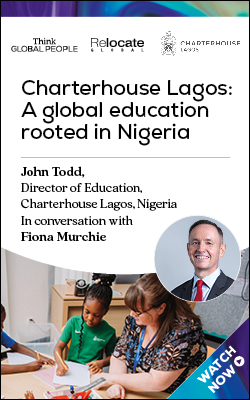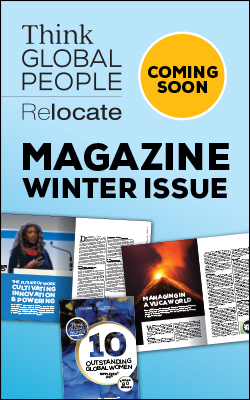Simple – right?
We look at Dr Morieux of the Boston Consulting Group's Institute for Organization on Smart Simplicity and how to create the structural and the behavioural groundwork for competitive change.

– the must read for HR, global managers and relocation professionals.Where HR goes with big ideas in people management, global mobility tends to follow. So, here’s the latest proposition from the realm of organisational transformation – the days of over-complicated strategic alignment are over, long live simplicity!Organisational sociologist and corporate transformation expert Dr Yves Morieux, currently Dubai-based as director of the Boston Consulting Group’s Institute for Organization, delivered this thought-provoking idea at the CIPD’s annual conference in Manchester.At its heart is the evidence-based conclusion that aligning organisational structures and processes won’t always result in their intended consequences in this age of complexity. Managerial and team overload frustrates engagement and productivity, and is leading to a downward spiral of organisational, team and individual performance.
A simple approach to complexity
Dr Morieux introduced his ideas on Smart Simplicity and how to create the structural and the behavioural groundwork for competitive change within the CIPD conference’s overarching themes of trust, inclusion and evidence-based solutions to human resources and people development.Based on his own extensive research, and designed in cooperation with over 500 BCG clients in different regions and industries, Smart Simplicity has been adopted by organisations including French rail operator, SNCF. His conceptualisation of the issues facing organisations offers six “smart rules” for better managing the new business complexity while avoiding organisational complications.Six simple rules for overcoming complexity*
The first three help to create the conditions for individual empowerment:1. Understand what your people and co-workers do by tracing performance back to behaviours and goals2. Reinforce integrators – those who make a positive difference to the work of others
3. Increase the total quantity of power when creating new roles by adding new tools simultaneously – people delivering a service are often those who see the problem and the solution, but often least able to help resolve itThese next three encourage people to face complexity and work co-operatively:4. Increase reciprocity so everyone’s success depends on everyone else’s
5. Extend the shadow of the future by tightening and speeding up feedback loops so people can see easily the consequences of their behaviour and decisions
6. Reward those who co-operate and penalise those who don’tTogether, their goal is to create an environment where employees can work together to develop simple and creative solutions to complex challenges. The role of managers is to guide and lead the behavioural impact of organisational structure on engagement and performance.
Enter the Think Relocate Awards 2019 to showcase your company’s achievements across the mobility sector
Network, learn from global leaders and develop ideas and solutions to global mobility challenges at our interactive the Festival of Global People 2019 on Tue 14- Wed 15th of May
A simple way to resolve the productivity paradox?
Reducing complexity in order to really understand the challenges and deliver more effective solutions is already in the business leaders’ lexicon. Announcing in December plans for significant restructuring, international news and media provider Thomson Reuters’s Chief Executive Officer, Jim Smith, said the strategy to increase sales would first see it “simplify the company in every way that we can, working on ways to make it easier both for our customers to do business with us and for our frontline troops to navigate inside the organization.”But, does smart simplicity offer more than a positive spin on restructuring, resource-shedding and redundancies? In the view Dr Morieux outlined in Manchester: yes, it absolutely does.His starting point is persistently low growth in output per worker; this despite technological advances and higher skilled jobs, across many western economies, including the UK and France. In his research team’s analysis, the common cause is how companies manage work: more accurately, the impact of the current focus on strategic alignment.In this narrative, alignment worked when the world was simple and when the art of strategy, according to thinkers like Professor Michael Porter, was to decide whether to compete on cost or quality, with processes and structure flowing from this.When customers demanded both cost and quality, there was a drive to differentiation. Matrix structures helped companies to deliver this by segmenting markets and production by product, customer, geography etc.“Every time there was a requirement, what did we do?” asked Dr Morieux. “We kept the same strategic alignment approach, creating dedicated systems, matrices, scorecard, committees, clusters, HQs, lines, countries. Aligning with one dimension, I can see what it means, but to align with two perpendicular dimensions becomes more abstract.”Today, the fourth industrial revolution is adding a further – necessary – layer of complexity. “We have tried to deal with the new complexity of business by becoming more complicated. We have added organisational complexity to business complexity,” he said.Organising intelligent responses to disruption
With external complexity a given, the challenge is how we deal with that from an organisational, structural, team and individual perspective.For Dr Morieux, much of this comes down to the role of managers. He believes organisational complicatedness has seriously impacted managers’ ability to work effectively.“Managers spend 40% of their time writing reports because they have to report on more and more KPIs, they have to do more planning and of course the plan never works in this fast-changing environment, so they have to re-plan, re-explain.“Another 30% of their time is spent in meetings because they have to coordinate with more and more functions. How much is left to be with their teams? At best, 30%.”Teams therefore are misdirected in the most effective priorities and guidance, guidelines, coaching and recognition, meaning members are working harder and harder on less value-adding activities, he suggests. The answer is to find ways to help companies use their collective intelligence better.“To me, this is not so much a matter of boxes, organisation chart or structure,” he said. “It is more what I would call the ‘nervous system’: how parts work together, of leadership. If leaders give people the right targets, priorities, instructions, guidance, guidelines, coaching and recognition, it will make a big difference.”- Assessing risk and the role of trust: managing in a world of global uncertainty
- Towards an inclusive workplace: Fostering a culture of authenticity, inclusiveness and well-being
- International Health Insurance
- Business leaders embrace the future at the CBI National Conference
- Turning on the taps of global talent pipelines
Squad goals – a simple view of talent
Linking back to the six steps to simplicity and the insights into the behaviour and action that support smarter workplaces, Dr Morieux offered an interesting example on managing teams, high-potential talent, reward and recognition from the competitive sport arena.Dr Morieux interviewed elite athletes to explore how individual high-performance is no guarantee of team success. Or, how in a relay when team members truly co-operate with each other – sacrificing something of their own performance for the greater good, rather than just comply – the baton moves faster than individual runners can.“Cooperation is another way of helping people make better use of their intelligence. It is a multiplier of productivity – it is a multiplier of intelligence, of engagement.“When we don’t cooperate as much as we should, then we arrive just too late, like the US [relay team], which won the war for talent, but lost the real war in the action. The less we corporate, the more resources we need to use to make up for the lack of cooperation.“This is to me what HR is about. If you think about Sprints, Sprint Masters, Daily Stand Ups, Squads, Chapters, Product Owners – whatever you want to call the agile manifesto – in the end it is about creating an environment that helps us to better leverage our collective intelligence of our people.”What might Smart Simplicity mean for mobility?
Dr Morieux’s narrative around creating the conditions that empower team and individual performance and face complexity is impactful because it speaks to the pervasive productivity and engagement deficits common in most western countries, and today’s key themes of the inclusion of all talents, a coaching style of leadership and the shift to more agile ways of working.It also raises key questions around how to create the conditions for true co-operation, for example around the role of reward structures in this and managing talent. While what gets measured gets done, most people would agree that to do a job that focuses on outcome only is not always the best use of our collective human resources, and one that has unintended consequences, such as disengagement and poor management.This simpler internal approach to complexity externally – one where managers return to managing people’s collective intelligence – is arguably a big shift that will require upskilling down the line in, for example, a coaching leadership style.It will also demand further research and evidence into the impact of simplicity and greater co-operation on reward and recognition, for example in performance metrics. Dr Morieux recognizes that when people co-operate, it’s not easy to the measure. Instead, he believes it requires leaders with good judgement, which is why managers are important. “We need people who pay attention: do your leaders know the moments of truth?”For now, when it comes to organisational transformation and behavior change in response to complexity, Dr Morieux says the role of HR is to “question and challenge,” “to put blood in our throats,” co-operate and speak up.What are your thoughts on a simple approach to managing complexity as they relate to HR and global mobility in your sector? Does this approach change the role and skillset of line managers? Is there still space for strategic alignment? These are just some of the many interesting questions this approach prompts.*Six simple rules for overcoming complexity paraphrased from https://www.bcg.com/capabilities/smart-simplicity/six-simple-rules-overcoming-complexity.aspx and https://www.bcg.com/publications/2014/behavior-culture-change-management-why-managers-need-six-simple-rules.aspxFor related news and features, visit our Human Resources section.Relocate’s new Global Mobility Toolkit provides free information, practical advice and support for HR, global mobility managers and global teams operating overseas.
 Access hundreds of global services and suppliers in our Online Directory
Access hundreds of global services and suppliers in our Online Directory
©2025 Re:locate magazine, published by Profile Locations, Spray Hill, Hastings Road, Lamberhurst, Kent TN3 8JB. All rights reserved. This publication (or any part thereof) may not be reproduced in any form without the prior written permission of Profile Locations. Profile Locations accepts no liability for the accuracy of the contents or any opinions expressed herein.


































